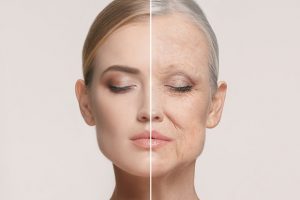Study shows how aging affects communication between skin cells

 Reviewed
Reviewed
A new research paper was published on the cover of Aging (listed by MEDLINE/PubMed as "Aging (Albany NY)" and "Aging-US" by Web of Science) Volume 15, Issue 22, entitled, "Chronological aging impacts abundance, function and microRNA content of extracellular vesicles produced by human epidermal keratinocytes."
The disturbance of intercellular communication is one of the hallmarks of aging. In their new study, researchers Taku Nedachi, Christelle Bonod, Julie Rorteau, Wafae Chinoune, Yuri Ishiuchi, Sandrine Hughes, Benjamin Gillet, Nicolas Bechetoille, Dominique Sigaudo-Roussel, and Jérôme Lamartine from the University of Lyon, Toyo University and Gattefossé SAS aimed to clarify the impact of chronological aging on extracellular vesicles (EVs), a key mode of communication in mammalian tissues.
"The present study was therefore conducted to elucidate whether the characteristics of EVs released from cultured human keratinocytes can be modulated during aging process."
The researchers focused on epidermal keratinocytes, the main cells of the outer protective layer of the skin which is strongly impaired in the skin of elderly. EVs were purified from conditioned medium of primary keratinocytes isolated from infant or aged adult skin. A significant increase of the relative number of EVs released from aged keratinocytes was observed whereas their size distribution was not modified.
By small RNA sequencing, the researchers described a specific microRNA (miRNA) signature of aged EVs with an increase abundance of miR-30a, a key regulator of barrier function in human epidermis. EVs from aged keratinocytes were found to be able to reduce the proliferation of young keratinocytes, to impact their organogenesis properties in a reconstructed epidermis model and to slow down the early steps of skin wound healing in mice, three features observed in aged epidermis. This work reveals that intercellular communication mediated by EVs is modulated during aging process in keratinocytes and might be involved in the functional defects observed in aged skin.
"To conclude, we have shown here that aging modulates EVs abundance, function and microRNA content in human keratinocytes."
Aging-US
Nedachi, T., et al. (2023). Chronological aging impacts abundance, function and microRNA content of extracellular vesicles produced by human epidermal keratinocytes. Aging. doi.org/10.18632/aging.205245.
Posted in: Cell Biology | Medical Science News | Medical Research News
Tags: 2D Culture, Aging, Cancer, covid-19, Epidermis, Exosomes, Gerontology, MicroRNA, Model Organisms, Molecular Biology, Pathology, Proliferation, Research, RNA, RNA Sequencing, Skin, Syndrome, Wound, Wound Healing